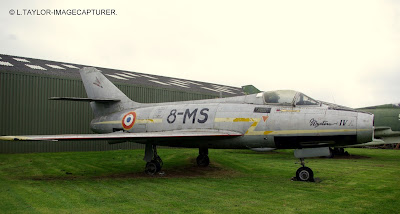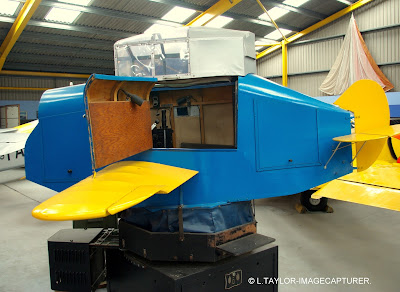DASSAULT MYSTERE IVA no 83.
INTERCEPTOR FIGHTER.
Built by Dassault in the mid 1950`s entered service with 8 escardre. Crew of one, max speed 695mph, range 570 miles, service ceiling 45,000feet. The aircraft is powered by a Hispano-Suiza Tay turbojet rated at 6,250lbs static thrust, this being a Rolls Royce design built under licence. It is armed with two 30mm cannon and can be fitted with four underwing pylons for up to 2000lbs of bombs.
~~~~<<<<>>>>~~~~
NORTH AMERICAN F.100D SUPER SABRE 54-2223.
TACTICAL FIGHTER BOMBER.
Left the factory on the 28th June 1956, entered service with Armee De L' Air in 1958. Crew of one, max speed 864mph, range 1,500 miles, service ceiling 55,000feet. The aircraft is powered by a Pratt and Whitney J67 P -21 -A turbojet with a thrust rating of 16,950lbs. It was armed with four 20mm cannon and could carry 7,500lbs of bombs.
~~~~<<<<>>>>~~~~
SAAB 91B SAFIR 56321 ( G-BK PY )
PRIMARY TRAINER.
Aircrew of three, max speed 165mph, range 660 miles, service ceiling 16,400feet, loaded weight 2,680lbs, span 34feet 9inches, length 25feet 11inches, height 7feet 3inches, armament none, power plant Lycoming 0-435-A engine rated at 190hp.
~~~~<<<<>>>>~~~~
DE HAVILLAND DH.82A TIGER MOTH G-MAZY ( DE156 )
BASIC TRAINER.
Aircrew of two, max speed 109mph, range 300miles, service ceiling 13,600feet, loaded weight 1,825lbs, span 29feet 4inches, length 23feet 11inches, height 8feet 9 1/2inches, armament none, power plant D.H.Gipsy Major rated at 130hp.
~~~~<<<<>>>>~~~~
DE HAVILLAND CHIPMUNK T.10 WB624.
PRIMARY TRAINER.
Aircrew of two, max speed 138mph, range 300miles, service ceiling 16,000feet, loaded weight 2,000lbs, span 34feet 4inches, length 25feet 8inches, height 7feet 1inch, armament none, power plant one De Havilland Gipsy Major MK8 in-line engine.
~~~~<<<<>>>>~~~~
VOLMER VJ - 24W G-MBBZ.
This microlight aircraft was built by David G. Cook and flown by him between 1980 and 1992. It was serial number 007 and is fitted with a Yamaha 97cc, 9hp engine. Maximum speed was 52mph and it would cruise at 40mph.
~~~~<<<<>>>>~~~~
BENSON B - 8M GYROCOPTER G - ASNY.
Built by Campbell Aircraft Ltd and originally supplied in kit form. Powered by a Mc Culloch four cylinder horizontally opposed engine rated at 72hp. Max speed 95mph, cruise 65mph, rate of climb 1100feet/min, max height 15,000feet.
~~~~<<<<>>>>~~~~
AVRO SHACKLETON MK3 PHASE 3 WR977.
LONG RANGE MARITIME RECONNAISSANCE/BOMBER.
Built at Woodford in 1957, entered service in 1958 with 220 squadron, carried a crew of ten, max spped 302mph, range 3,660 miles, service ceiling 19,200feet. The aircraft is powered by four Rolls Royce Griffon 58 engines each rated at 2,450hp plus two Viper auxiliary turbojets. It can carry three homing torpedoes, nine depth charges and 12 sonobuoys. It was also fitted with 2 x 20mm cannon in the aircrafts nose.
~~~~<<<<>>>>~~~~
TAYLOR JT.1 MONOPLANE.
Weight empty 400lbs, max take off weight 610lbs, max speed 104mph, cruise speed 92mph, stalling speed flaps up 40mph, stalling speed flaps down 34mph, rate of climb at sea level 950feet/min, range 230miles. The aircraft pictured here is the prototype JT.1 Monoplane built by the designer John Taylor. He designed it in 1956 with a cost limitation of £100 and it was to be built in his lounge at home which restricted the length to no more than 16 feet. It was completed in 1959 and made its first flight on the 4th July of that year. Originally it was powered by a 38hp Jap Twin - cylinder engine, this was replaced in 1964 with a 45hp 1600cc Ardem 4C02 unit ( converted VW car engine ).
~~~~<<<<>>>>~~~~
WARD GNOME.
This aircraft was designed by Mike Ward of north Scarle and made its first flight from Wigsley airfield on the 4th August 1967. It was the smallest registered aircraft in the United Kingdom and was powered by a modified Douglas Motorcycle engine rated at 14hp.
~~~~<<<<>>>>~~~~











































